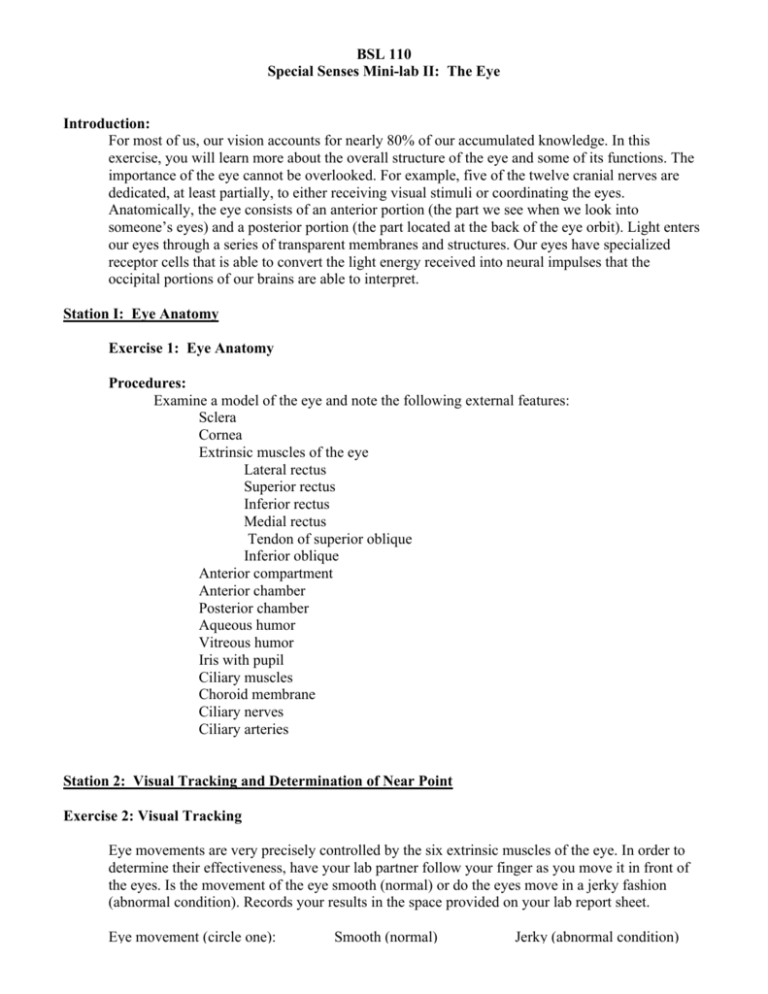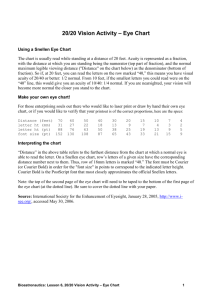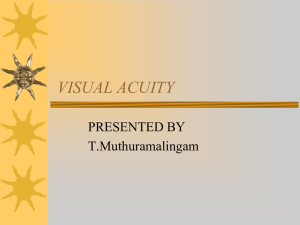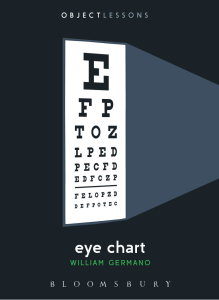BSL 110 Special Senses Mini-lab II: The Eye Introduction: For most
advertisement

BSL 110 Special Senses Mini-lab II: The Eye Introduction: For most of us, our vision accounts for nearly 80% of our accumulated knowledge. In this exercise, you will learn more about the overall structure of the eye and some of its functions. The importance of the eye cannot be overlooked. For example, five of the twelve cranial nerves are dedicated, at least partially, to either receiving visual stimuli or coordinating the eyes. Anatomically, the eye consists of an anterior portion (the part we see when we look into someone’s eyes) and a posterior portion (the part located at the back of the eye orbit). Light enters our eyes through a series of transparent membranes and structures. Our eyes have specialized receptor cells that is able to convert the light energy received into neural impulses that the occipital portions of our brains are able to interpret. Station I: Eye Anatomy Exercise 1: Eye Anatomy Procedures: Examine a model of the eye and note the following external features: Sclera Cornea Extrinsic muscles of the eye Lateral rectus Superior rectus Inferior rectus Medial rectus Tendon of superior oblique Inferior oblique Anterior compartment Anterior chamber Posterior chamber Aqueous humor Vitreous humor Iris with pupil Ciliary muscles Choroid membrane Ciliary nerves Ciliary arteries Station 2: Visual Tracking and Determination of Near Point Exercise 2: Visual Tracking Eye movements are very precisely controlled by the six extrinsic muscles of the eye. In order to determine their effectiveness, have your lab partner follow your finger as you move it in front of the eyes. Is the movement of the eye smooth (normal) or do the eyes move in a jerky fashion (abnormal condition). Records your results in the space provided on your lab report sheet. Eye movement (circle one): Smooth (normal) Jerky (abnormal condition) Exercise 3: Determination of the Near Point The minimum distance an object can comfortably be held in focus is called the near point. The ability of the eye to focus is due to the elasticity of the lens. The pliability of the lens decreases with age. A 10-year old cn focus 8- to 10-cm away from the eye, yet a 65-year old may not be able to focus closer than 80- to 100-cm. The stiffening of the lens becomes noticeable around 40 to 50 years of age, when many people find reading glasses necessary because their aging lenses do not accommodate as well as the lenses of a younger person. You can measure your near point by holding a sharp object such as a pencil or fine probe vertically at arm’s length in front of you. Close one eye and slowly move the object closer until either you see two objects or it becomes blurry. Have your lab partner measure the distance, in centimeters, from your eye to the object. This is the near point distance. Be careful not to get the sharp point too close to your eye! Measure the near point for both eyes, in centimeters, and record the data on your lab report sheet. Near point of right eye: __________________________ cm Near point of left eye: ___________________________ cm Station 3: Color-Blindness Test and Snellen Test for Visual Acuity Exercise 4: Color-Blindness Test Color vision is dependent on three separate cone cell sensitivities. Cones may be red, green or blue sensitive. Changes in the genes on the X-chromosome are the most common cause of colorblindness. Some people may be unable to see a particular color at all, while others may have a reduction in their ability to see a particular color. Color blindness is most common in males and relatively rare in females. This can be understood by examining the chromosomal makeup of the two sexes. The male chromosome makeup is XY. The Y chromosome does not carry the gene for color vision. If the X chromosome carries a gene for color-blindness, then the male will exhibit colorblindness. On the other hand, if a female carries the gene for color blindness on the Xchromosome, the chances are that she will have a normal gene on the other X-chromosome. The normal gene is expressed, cone pigments are produced and the female has normal color vision. You can test for color-blindness by using the Ishihara color charts. Use these charts by flipping through the book and viewing plates #1 through #11 with a lab partner and recording which charts were accurately viewed and which plates, if any, were missed. Pages 4 and 5 on the key provided will give students additional information regarding the plates and an individual’s ability to read each plate. You can assess the type and degree of color-blindness using the following information: As assessment of the readings of plates 1 to 11 determine the normality or defectiveness of color vision. If 10 or more plates are read normally, the color vision is regarded as normal. If only 7 or less than 7 plates are read correctly, the color vision is regarded as deficient. However, in reference to plate number 9, only those who read the numerals 2 and read it easier than those on plate 8 are recorded as abnormal. It is rare to find a person whose recording of normal answers is 9 or 8 plates. An assessment of such a case requires other color vision tests. Exercise 5: Snellen Test (Visual Acuity Test) The Snellen test is a common procedure used to determine the visual acuity of an individual. Face the Snellen eye chart from 20 feet away (see taped area on floor of lab aisles). Cover on eye with a 4x6 index card and have your lab partner point to the largest letter on the chart. Do not read the chart with both eyes open. You lab partner should then progressively move down the chart and note the line that has the smallest print in which you made no errors. You lab partner should record the number at the side of the line. This number refers to your visual acuity. Now switch the card to the other eye and repeat the test. Record your results on your lab report sheet. A vision of 20/20 is considered normal. In 20/20 vision, you can see the same details at 20 feet that most other people can see at the same distance. If your vision is 20/15, then you can see at 20 feet what most people can see at 15 feet. If you vision is 20/100, then you see at 20 feet what most people see at 100 feet. Station 4: Class Exercise: Pupillary Response Class Exercise 6: Pupillary Reactions Work in groups of 2’s or 3’s. Dim the laboratory lights for at least one to two minutes and then examine each other’s eyes within your group. Observe the size of the pupils and note that under dim lights, each student’s pupils should be dilated. Now, shine a penlight briefly into each student’s right eye. What happened to the student’s pupil diameter when the light was shown into their right eye? Repeat the procedure for the left eye and observe what happens to the left pupil. Did the same thing occur in the student’s left eye? LAB REPORT SHEET Vision Name __________________________ Section __________ Score _______ Exercise 1: Eye Anatomy 1. Label the following illustration using the terms provided: Lens, Retina, Choroid, Sclera, Optic Nerve, Anterior Cavity (anterior chamber) 2. How does vitreous humor differ from the aqueous humor in terms of location and viscosity? 3. How is vitreous humor used in forensic pathology? Exercise 2: Visual Tracking 1. Record the results of your visual tracking test here: Eye movement (circle one): Smooth (normal) Exercise 3: Determination of Near Point 1. Record your data: Near point of right eye: ____________________ cm Near point of left eye: _____________________ cm Jerky (abnormal) 2. How does the near point vary with age? 3. How would you define the near point of the eye? Exercise 4: Color Blindness Test 1. Record the images you saw (or didn’t see) for each of the plates viewed: 1. 2. 3. 4. 5. 6. _________________ _________________ _________________ _________________ _________________ _________________ 7. ________________ 8. ________________ 9. ________________ 10. ________________ 11. ________________ 2. Based on your results, how would you describe your color-vision? Exercise 5: Snellen Test for Visual Acuity 1. Record your data: Right eye: __________________ Left eye:__________________ 2. What do the numbers 20/50 mean for visual acuity? Exercise 6: Pupillary Response 1. What happened to the students’ pupils when a light was shined onto them? Explain why this occurred.








